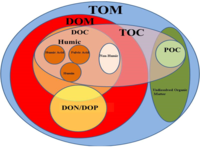
Photo from wikipedia
Manual measurements of nitrous oxide (N2 O) emissions with static chambers are commonly practiced. However, they generally do not consider the diurnal variability of N2 O flux, and little is… Click to show full abstract
Manual measurements of nitrous oxide (N2 O) emissions with static chambers are commonly practiced. However, they generally do not consider the diurnal variability of N2 O flux, and little is known about the patterns and drivers of such variability. We systematically reviewed and analysed 286 diurnal datasets of N2 O fluxes from published literature to: (i) assess the prevalence and timing (day or night peaking) of diurnal N2 O flux patterns in agricultural and forest soils; (ii) examine the relationship between N2 O flux and soil temperature with different diurnal patterns; (iii) identify whether non-diurnal factors (i.e. land management and soil properties) influence the occurrence of diurnal patterns; and (iv) evaluate the accuracy of estimating cumulative N2 O emissions with single-daily flux measurements. Our synthesis demonstrates that diurnal N2 O flux variability is a widespread phenomenon in agricultural and forest soils. Of the 286 datasets analysed, ~80% exhibited diurnal N2 O patterns, with ~60% peaking during the day and ~20% at night. Contrary to many published observations, our analysis only found strong positive correlations (R > 0.7) between N2 O flux and soil temperature in one-third of the datasets. Soil drainage property, soil water-filled pore space (WFPS) level and land use were also found to potentially influence the occurrence of certain diurnal patterns. Our work demonstrated that single-daily flux measurements at mid-morning yielded daily emission estimates with the smallest average bias compared to measurements made at other times of day, however, it could still lead to significant over- or underestimation due to inconsistent diurnal N2 O patterns. This inconsistency also reflects the inaccuracy of using soil temperature to predict time of daily average N2 O flux. Future research should investigate the relationships between N2 O flux and other diurnal parameters such as photosynthetically active radiation (PAR) and root exudation, along with the consideration of the effects of soil moisture, drainage, and land use on the diurnal patterns of N2 O flux. The information could be incorporated in N2 O emission prediction models to improve accuracy.
Journal Title: Global change biology
Year Published: 2021
Link to full text (if available)
Share on Social Media: Sign Up to like & get
recommendations!